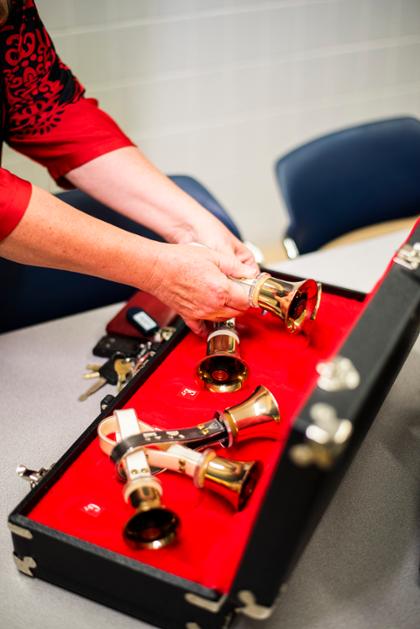“In a bell choir, if someone is absent it’s like having to tape down a key on a keyboard and you can’t play that note,” she explained.
Over the years, Huffman (BS ‘86, MS ‘87) became enamored with the art, history, and even the mathematics of handbells.
Today, she performs as a soloist for special events like the Timmons Christmas Concert on campus, and she uses them in her classes in Yates Hall to make mathematics more engaging for her students. Yes, mathematics.
She can play up to six bells at a time, three in each hand. With a sort of flick of her wrist and hammering motion, the clapper in each strikes the side of the bell, each tuned to correspond with a note on the keyboard. The white-handled bells represent the white notes in an octave, and the black-handled bells represent the black notes — the sharps and flats.

“I have to admit, it took several months of lots of practice to kind of get the feel for how to turn my wrist to make them play,” she said.
Their history is fascinating, Huffman explained:
For hundreds of years in England, large bells in church towers were rung to announce births and deaths, victories and defeats, to proclaim when it was time for markets to open, or residents to awaken or go to sleep. The British devised a mathematical system of ringing them called change ringing, with bells rung in a particular order.
But change ringing was noisy when the bell ringers practiced, and might inadvertently alarm the townspeople, so in the 1600s, the British invented handbells — one for each large bell in the tower. It allowed change ringers to rehearse on a much smaller, quieter scale.
“Change ringing compositions or playing bells in different orders to mean different things — that’s math from an area called abstract algebra,” she said. “With four bells, there are 24 possible combinations.”
By 1680, mathematicians had begun publishing books about change ringing and how to achieve all possible permutations, or possible variations in which a set or number of things can be ordered or arranged.
In addition to teaching her students math in this way, Huffman also incorporates clothing she’s purchased on her travels to other countries.
“When I teach Egyptian math, I wear a robe I found in Egypt,” she said. “When I teach Mayan math, I wear something from Guatemala. And I wear a wig when I teach about Émilie du Châtelet — a French female mathematician from the 1700s.”
“I want to make mathematics fun, exciting, and relevant for the students,” she said. “I like to talk about where things are used, but I also like to tell the history, where it came from, and why people developed it.”
Listen to this story as a podcast:
Gorilla Connection: Handbells & MatheMatics
Learn more: